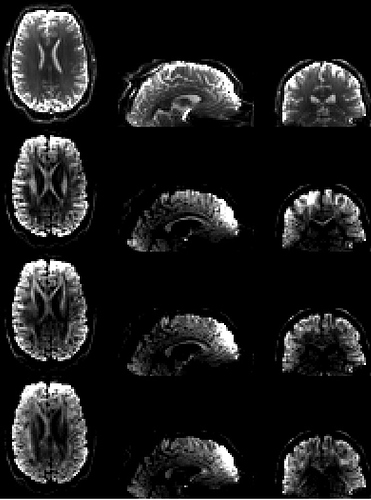How do we read a .bvals and .bves files which I suppose contains b values ?
The bval and bvec files are text files, you can view them with a text editor. The format was devised by the FSL group, but is supported be many tools (MRtrix, AFNI, FSL, DSIstudio, etc).
The bval file lists the b-value for each volume in the series.
The bvec file lists the gradient direction, with one column per volume. Each column of the text file has three rows, describing a unit vector with x,y,z components. In FSL format, these values are with respect to image space (row, column, slice) rather than world space (left-right, anterior-posterior, head-foot).The one unintuitive bit is that FSL will flip the order of the image rows depending on the determinant of the image.
Hi @Chris_Rorden thanks for the response. I have one doubt. When i opened a dMRI file I saw that there were 32 files within the DMRI .nii file. When I tried to search the answer i got was that 32 different samplings acquired in volume setting. I did not understand the reason properly. Will it be possible for you to explain this. And also does the b value signify the strength of the magnetic field. Suppose if b = 0 does it mean that no magnetic field was present and at b = 0 are the diffusion characteristics captures
I would suggest you look at the dcm2niix manual’s DTI section. It includes a dedicated word document describing how to check sequences, and links to download sample data. The image below shows raw DWI data with a few volumes, as seen with MRIcroGL (the Display/NextVolume menu item lets you cycle between volumes). In this example, the first row shows a b=0 volume that is not sensitive to any specific directions - it looks like a T2 image, with fast-moving water appearing bright. The other rows show volumes with b=1000 and different gradient vectors applied. Note that different directions highlight fibers of different orientations. By combining these, we can infer fibers.
Hi @Chris_Rorden thanks for the response. It was really helpful and it is making me understand and visualize things. So, in b = 0 setting if not any fibers are specific what is the advantage of acquiring b = 0 is it that we get to know the volume of water.
While b=0 images do not inform you regarding the direction of water movement, they provide a baseline that provides the denominator for many of the scalar values. Think of them as a way to calibrate the values, e.g. we do not only want to know the vector direction, but also the length. Beyond this, since the unbiased and high-SNR properties of these images make them crucial for undistortion of diffusion sequences. A nice rule of thumb is to include several b=0 volumes in the diffusion sequence of your diffusion images.
